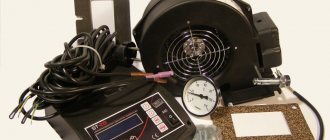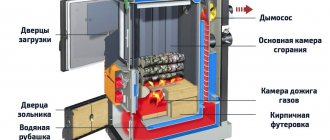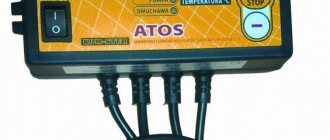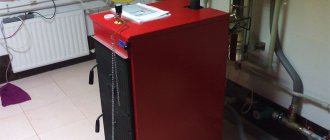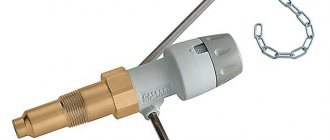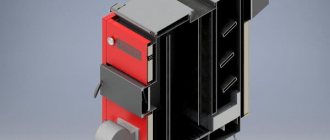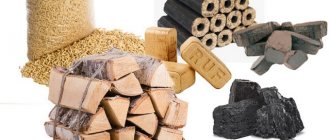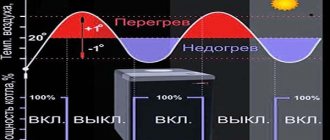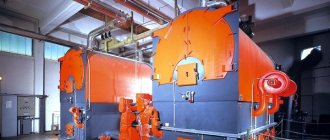Home / Solid fuel boilers
Back
Published: 02/27/2020
Reading time: 5 min
0
6389
Installation of a blower fan on a solid fuel boiler is carried out to optimize combustion processes, which leads to an increase in the efficiency of the thermal circuit and fuel economy.
A fan for a solid fuel boiler can be made independently, which will allow the owner to save significant funds on purchasing a factory-made analogue.
- 1 Purpose of a fan for a boiler
- 2 Design and principle of operation
- 3 Varieties 3.1 Electrically commutated motor
- 3.2 Synchronous motor
- 3.3 Blowers with asynchronous motor
Purpose of a boiler fan
A modern heat supply system involves the installation of an automation unit to regulate the thermal processes of the boiler. It is based on changing the supply of air, which is supplied to the combustion zone by a blower fan and is considered more progressive compared to gravity systems.
The completeness of fuel combustion and the operational productivity of a solid fuel unit largely depend on the volume of supplied air and the size of the draft in the combustion chamber.
The automation unit is equipped with a controller that, according to an established algorithm, regulates the operation of the blower, supplying different volumes of air, thereby supporting the combustion process and, accordingly, the production of a certain amount of thermal energy.
The use of a fan in the boiler control system allows:
- maintain the required temperature of the heating fluid in the heating system;
- increases the time the unit reaches operating mode;
- optimizes solid fuel combustion processes;
- increases the efficiency of a solid fuel installation;
- facilitates the process of servicing the heat supply system;
- reduces specific fuel consumption for the production of 1 Gcal of thermal energy.
Air
- Manufacturer: Ukraine;
- Power supply: 220V/50Hz;
- Connected pump power: up to 450W;
- Fan power: up to 220 W;
- Coolant temperature setting range: 40-85oC;
- Temperature measurement accuracy: 0.1°C
- Room temperature setting range: 20-45oC;
- Estimated cost: 3000-3500 rubles.
Compact automatic control unit for solid fuel boilers. Allows installation and control of a powerful circulation pump and fan with a corresponding load current of 2 and 1 ampere; the modification allows load currents of up to 5A.
- Manufacturer: Poland;
- Power supply: 220V/50Hz;
- Connected pump power: up to 200W;
- Fan power: up to 200 W;
- Coolant temperature setting range: 30-80°C;
- Temperature measurement accuracy: 1°C;
- Room temperature setting range: 20-45oC;
- Manual target temperature setting and circulation pump control.
- Estimated cost: 6500-7250 rubles.
Functional control unit with practical overheat-protected housing. User-friendly interface. The presence of an LCD display and an expanded set of control keys makes it easier to configure the automation and control the operation of the boiler.
Design and principle of operation
Regardless of the manufacturer, the fan consists of an aluminum or galvanized housing, inside of which there is an electric motor, guide blades and protection in the form of a lattice fence.
This design, despite its simplicity and small dimensions, is reliable. A damper is installed on the supercharger, which is designed to limit the penetration of flue gases into the combustion room in the event of reverse draft.
Also, the damper reduces natural draft when there is no air supply.
The connecting pipes can be located in the upper part of the housing or on the front part of the blowing unit and have various forms of connectors for connection to the boiler. Algorithm for the functioning of the boiler control system using blown air:
- the heating device is filled with solid fuel and ignited;
- the blower is turned on and the air flow is regulated;
- when air is supplied to the combustion zone, intense combustion of the fuel begins, and therefore the temperature of the coolant begins to rise;
- when the temperature reaches the set value, the control unit controller gives a signal to turn off the supercharger;
- air deficiency will lead to a decrease in the intensity of fuel combustion and a decrease in coolant temperature.
Classification of smoke exhausters
Before installing the exhaust machine, you can try to do without it, increasing the draft with special devices that do not require forced air distillation and energy consumption. Sometimes an extended pipe or installing a deflector on the top helps. If the problem cannot be resolved, you can use:
- natural draft enhancer;
- flow exhauster;
- centrifugal exhaust fan.
The first of them consists of a fan mounted on the top of the chimney and connected to a control panel. The simplest and cheapest option, but its performance is low.
In the second design, the hood housing with the impeller is placed in the smoke duct, and the electric motor is installed outside. This configuration allows the use of engines and turbines of any power.
The highest performance of a centrifugal smoke exhauster. This design allows you to service chimneys with the most complex configuration and large cross-section.
In this video you will learn how to make a smoke exhauster:
Varieties
Today, in the retail chain, it is possible to purchase various models of blower fans for solid fuel heating units, both domestic and European assembled.
The most popular options for the location of blowing units are:
- The invoice is installed on a vertical section of an uninsulated smoke ventilation duct.
- Centrifugal duct, have two mounting pipes installed in the chimney gap.
- Boiler installed directly on the heating device.
The following classification of blowing units is made according to the type of electric motors: asynchronous, electrically commutated EC and synchronous.
Electrically commutated motor
The Electronically Commutated Motor (EC) allows very precise performance adjustments using a pulse width modulation signal.
Electrically commutated drive
In the case when they are installed on blowing devices, it becomes possible, by changing the speed of rotation of the impeller - impeller, to change the volume of air supplied to the furnace, thereby reducing energy consumption from 50 to 80%.
Despite the high cost of such blowing devices, they are preferable in the installations of modern boiler units, since they are energy-efficient devices, and their use reduces emissions into the environment by reducing thermal energy losses due to underburning of fuel.
EC motors operate in a quiet range and have an extended service life.
Synchronous motor
The blower fan for a boiler with a synchronous motor is characterized by a simple design and a low price. The disadvantages of this model include a limited adjustment range and low torque when starting the engine. As a rule, such blowing devices are installed to supply a constant volume of air into the combustion chamber.
Boilers with fairly large dimensions are equipped with such engines. Basically, such engines are mounted in a separate block.
When operating synchronous motors at low speeds, winding overheating often occurs. In an exhaust type boiler, fans are installed on the chimney; they are also called smoke exhausters.
Blowers with asynchronous motor
Such electric motors have many advantages. They are convenient and easy to maintain and are durable in design. A disadvantage of this type of electric drive is high starting currents.
Therefore, it will be necessary to properly arrange the power part in order to put into operation such a device that is sensitive to current parameters.
The asynchronous electric motor makes it possible to easily adjust the speed. Certain modifications also have a reverse mode. The main positive qualities of fans with an asynchronous electric motor:
- simple and easy to use;
- have a durable design;
- traditional control scheme;
- used by a variety of control systems paired with a thermostat, for example, like the budget fan DP-02 from a Polish manufacturer.
Causes of failure
The smoke exhauster may be faulty for the following reasons:
- The inductor is damaged. Under the influence of high temperatures resulting from the removal of hot gases or motor overload, the insulation of the wire melts, which leads to an interturn short circuit or a break in the coil winding.
- The turbine is unbalanced. During the process of removing smoke, the fan blades become covered with soot, dust, etc., which leads to a change in the center of gravity of the wheel.
- Bearings are worn out. The armature shaft is equipped with plain or rotation bearings. If the turbine is unbalanced or there is insufficient lubrication, the service life of these components is reduced.
- There is no power to the smoke exhauster. The impeller will not rotate if the control board module responsible for supplying power to the fan is faulty.
- Low mains voltage. When the electrical voltage supplied to the boiler is less than 195 volts, the pressure switch can turn off the fan, since due to the reduction in power, sufficient vacuum is not created. An underestimated gas boiler supply voltage does not lead to fan failure but creates the effect of a malfunction.
Features of choice
The performance of a boiler unit operating on solid fuel is largely determined by a professionally selected supercharger.
In order to choose the right fan, you need to pay attention to the following parameters:
- Comparable with heating boiler.
- Blowing device performance and operating voltage.
- Type and principle of operation.
- Metal housing and working impeller.
If the equipment is chosen incorrectly, when the fan for a solid fuel boiler is unable to supply the required volume of air to the furnace, the process of incomplete combustion of the fuel will begin, the efficiency of the boiler will drop, and the temperature regime will not be achieved.
If the blower is installed with high power, it will release a large amount of air into the firebox. The combustion process will be intense, the boiler will quickly reach the required temperature and the control unit controller will give a signal to turn off the fan, thus the blowing device will enter the clocking process, when it will often turn on and off, which will lead to premature wear of the equipment and its failure.
Recommended installation options for WPA fans for ZOT or Carbon boilers, for heating units operating on anthracite:
- WPA 120, incoming air volume - 285 m3, power - 32, kW.
- WPA 140, incoming air volume - 395 m3, power - 44, kW.
- WPA 142, incoming air volume - 505 m3, power - 56, kW.
- WPA 160, incoming air volume - 600 m3, power - 67, kW.
Atos
- Manufacturer: Poland;
- Power supply: 220V/50Hz;
- Connected pump power: up to 130W;
- Fan power: up to 130 W;
- Coolant temperature setting range: 35-80°C;
- Temperature measurement accuracy: 1°C
- Room temperature setting range: 25-50°C;
- Alarm when the set temperature range is exceeded;
- Relay output for additional alarm;
- Manual target temperature setting and circulation pump control.
- Estimated cost: 6750 rub.
